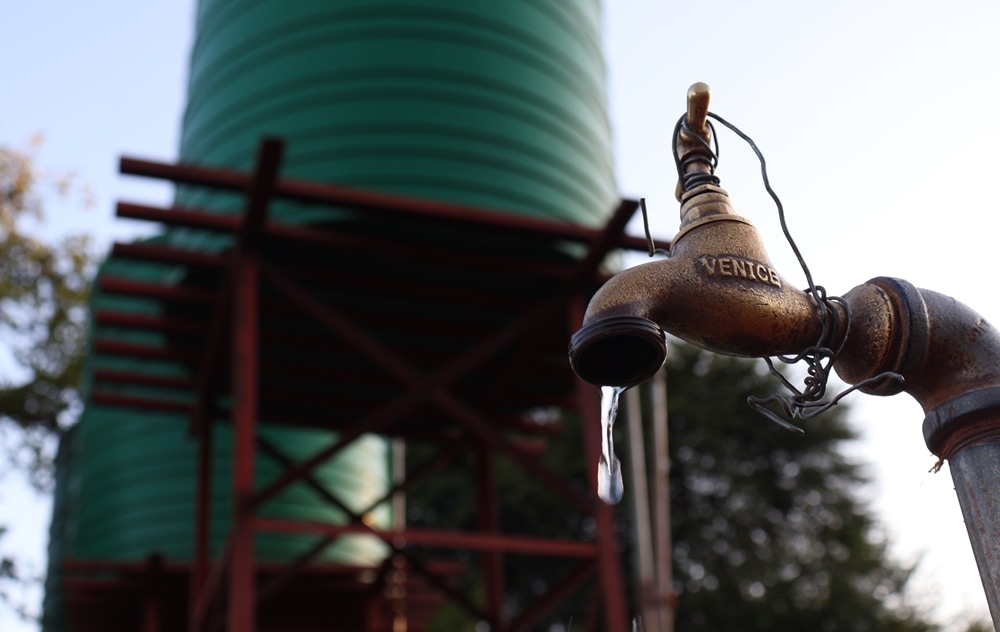By prof. Anja du Plessis
In the past few years, specifically since 2021, the complete continuous neglect, misappropriation of funds and absence of sound water resource planning and management has resulted in Gauteng’s water infrastructure being in a state of disrepair – and now also creeping closer to a possible localized collapse with the public who fear the ever-present threat of “day zero”.
The province faces very high risks of water insecurity, with consumers experiencing either low flows and dry taps due to water shortages and/or prolonged outages. Water insecurity is a real risk and a real threat to our water supply that must be urgently addressed in a logical manner. Gauteng represents almost a third of the country’s GDP and is home to a quarter of the population. If nothing is done, serious failure in water supply can be achieved. This will be disastrous for the region as well as for South Africa.
Immediate and important challenges
Although the province needs long-term solutions for its assured water security, there are two immediate challenges that have been identified as requiring major attention and intervention.
The eight-year delay in phase two of the Lesotho Highlands Water Project has resulted in the current water use being more than the available safe supply. A large gap therefore exists between actual use and reliable supply. The gap is large and is estimated at 400 million liters per day, which represents about 10% of current water use. Gauteng also experiences periods of high vulnerability, specifically during periods of low rainfall as long as the said gap exists.

The reality
The water reality for Gauteng consumers is in the form of frequent and prolonged water shortages, which lead to dry taps for long periods – days and even weeks – with no accurate and honest indication of when water will be restored.
The lack of communication and transparency creates both frustration and confusion – “why don’t I have water when the dams are full?”. The primary contributors to increased levels of dry taps include local storage volumes not keeping pace with the increased water use associated with population growth and socio-economic growth – consistent blame and poor planning.
The water system is also vulnerable to power outages and/or load shedding. Underinvestment, misappropriation of funds or even municipalities returning money to the treasury after it has not been used has led to no or insufficient maintenance of water infrastructure. This leaves a large backlog, which in turn causes systems to be more vulnerable and less reliable – increasing non-revenue water (physical and commercial losses, theft and vandalism), which exacerbates vulnerabilities within the water distribution system at an accelerated rate.

Insufficient progress
Despite both the problems and solutions being known, very little progress is being made. Some of the reasons attributed to our current state of affairs include the following.
Firstly, institutions responsible for investments and management of infrastructure are faced with the fact that their financial and technical capacity does not match the scope and complexity of the challenge. The regional water system depends on revenue from customers to support the necessary investments that in turn maintain the service. However, the municipal water services businesses are in financial trouble due to long-term underinvestment and the effects of non-revenue water (increased water losses = less income) which cause these businesses to no longer be financially viable, with their failure having an impact on the financial viability of Rand Water and undermining the ability of the Department of Water and Sanitation to fund investments to increase supply.
Secondly, the lack of trust between the consumer and the service provider and/or government department is currently entrenched due to continued unreliable and poor services. The instinctive tendency of institutions to be defensive, deflect blame and/or provide no information at all has unfortunately led to low levels of trust.
Other increasing threats which mainly include theft and/or vandalism and corruption lead to high and unsustainable costs on an already fragile system. Frequent power outages and load shedding negatively affect infrastructure and weak economic growth limits affordability.
The high and ever-increasing water security risks, if left as such, increase the increasing likelihood of a catastrophic failure in the region’s water supply. A series of efforts have been made in the public sector, private sector partnerships and some mobilization of civil society, but the rate of progress is insufficient to prevent significant water shortages in the province.

Some solutions
The water systems must be brought into a balance at the local level which is achieved when water consumption is less than the reliable water supply. This requires increased supply and reduction of water use by increasing capacity as well as improving the reliability of the bulk and distribution infrastructure.
Phase two of the Lesotho Highlands Water Project is the most important supply-side intervention in the medium term and its progress must be monitored to ensure that it is not delayed further. Other supply-side solutions include investments in groundwater, water reuse, rainwater harvesting, greywater harvesting and many more.
Reduced water use is the most cost-effective in the short term and requires a concerted effort from the customers but also the institutions that supply water, i.e. Rand Water and Gauteng municipalities. Efforts must come from all sides. Investments are needed to increase the capacity and resilience of the bulk water supply and distribution systems. Improvements are needed in overall system management and optimization to increase reliability.
To face our reality
The reality we all need to recognize is that we are facing a tipping point and need to have coordinated and realistic conversations about the tremendous number of water challenges and problems in the region.
Without a clear understanding of all the issues driving water insecurity, we will not be able to correctly identify priority areas that require immediate intervention (that is, areas where water infrastructure is compromised and close to collapse) to ensure the integrity of the system and avoid failure.
Some efforts have tried to address increased water shortages, but these have not yet achieved the required results. Different plans are therefore required and must be used and/or developed on an urgent basis.
- Prof. Anja du Plessis is an associate professor in water management expertise at Unisa.








